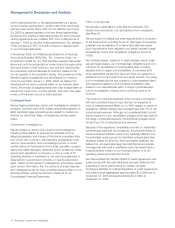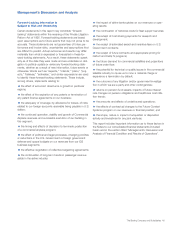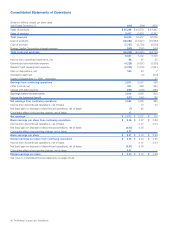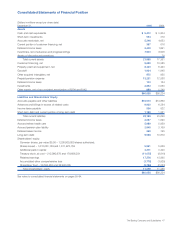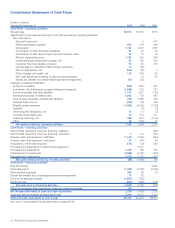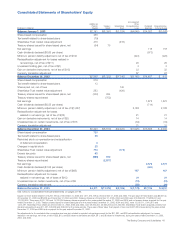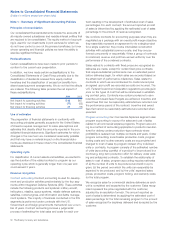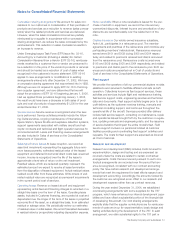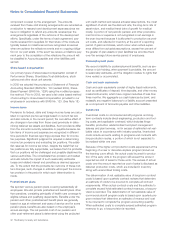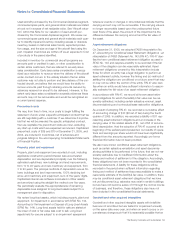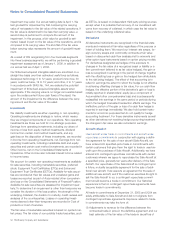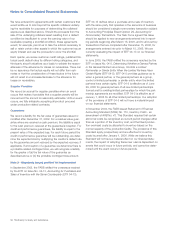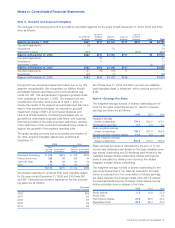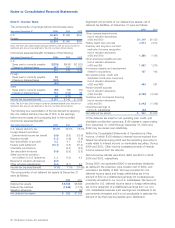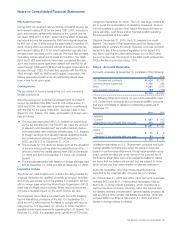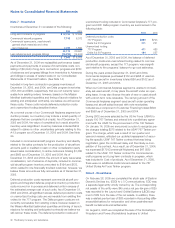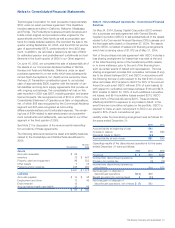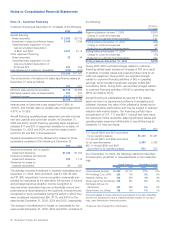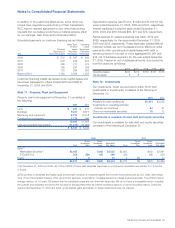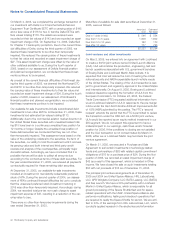Boeing 2005 Annual Report Download - page 56
Download and view the complete annual report
Please find page 56 of the 2005 Boeing annual report below. You can navigate through the pages in the report by either clicking on the pages listed below, or by using the keyword search tool below to find specific information within the annual report.Notes to Consolidated Financial Statements
impairment may exist. Our annual testing date is April 1. We
test goodwill for impairment by first comparing the carrying
value of net assets to the fair value of the related operations. If
the fair value is determined to be less than carrying value, a
second step is performed to compute the amount of the
impairment. In this process, a fair value for goodwill is esti-
mated, based in part on the fair value of the operations, and is
compared to its carrying value. The shortfall of the fair value
below carrying value represents the amount of goodwill impair-
ment.
As a result of IDS reorganizing from four business segments
into three business segments, we will be performing a goodwill
impairment assessment as of January 1, 2006, in addition to
our annual test as of April 1, 2006.
Our finite-lived acquired intangible assets are amortized on a
straight-line basis over their estimated useful lives as follows:
developed technology, 5 to 12 years; product know-how, 30
years; customer base, 12 to 15 years; and other, 2 to 17 years.
In accordance with SFAS No. 144, we evaluate the potential
impairment of finite-lived acquired intangible assets when
appropriate. If the carrying value is no longer recoverable based
upon the undiscounted future cash flows of the asset, the
amount of the impairment is the difference between the carry-
ing amount and the fair value of the asset.
Investments
We classify investments as either operating or non-operating.
Operating investments are strategic in nature, which means
they are integral components of our operations. Non-operating
investments are those we hold for non-strategic purposes.
Earnings from operating investments, including our share of
income or loss from equity method investments, dividend
income from certain cost method investments, and any
gain/loss on the disposition of these investments, are recorded
in Income from operating investments, net. Earnings from non-
operating investments, including marketable debt and equity
securities and certain cost method investments, are recorded in
Other income, net on the Consolidated Statements of
Operations. Other income also includes interest income related
to income taxes.
We account for certain non-operating investments as available-
for-sale securities, including marketable securities, preferred
stock, Equipment Trust Certificates (ETCs) and Enhanced
Equipment Trust Certificates (EETCs). Available-for-sale securi-
ties are recorded at their fair values and unrealized gains and
losses are reported as part of Accumulated other comprehen-
sive loss on the Consolidated Statements of Financial Position.
Available-for-sale securities are assessed for impairment quar-
terly. To determine if an impairment is other than temporary we
consider the duration of the loss position, the strength of the
underlying collateral, the duration to maturity, credit reviews and
analyses of the counterparties. Losses on operating invest-
ments deemed other-than-temporary are recorded in Cost of
products or Cost of services.
The fair value of marketable securities is based on quoted mar-
ket prices. The fair value of non-publicly traded securities, such
as EETCs, is based on independent third party pricing sources
except when it is probable that recovery of our investment will
come from recovery of collateral, in which case the fair value is
based on the underlying collateral value.
Derivatives
All derivative instruments are recognized in the financial state-
ments and measured at fair value regardless of the purpose or
intent of holding them. We record our interest rate swaps, for-
eign currency swaps and commodity contracts at fair value
based on discounted cash flow analysis and for warrants and
other option type instruments based on option pricing models.
For derivatives designated as hedges of the exposure to
changes in the fair value of a recognized asset or liability or a
firm commitment (referred to as fair value hedges), the gain or
loss is recognized in earnings in the period of change together
with the offsetting loss or gain on the hedged item attributable
to the risk being hedged. The effect of that accounting is to
reflect in earnings the extent to which the hedge is not effective
in achieving offsetting changes in fair value. For our cash flow
hedges, the effective portion of the derivative’s gain or loss is
initially reported in shareholders’ equity (as a component of
Accumulated other comprehensive loss) and is subsequently
reclassified into earnings in the same period or periods during
which the hedged forecasted transaction affects earnings. The
ineffective portion of the gain or loss of a cash flow hedge is
reported in earnings immediately. We also hold certain instru-
ments for economic purposes that do not qualify for hedge
accounting treatment. For these derivative instruments as well
as other derivatives not receiving hedge accounting treatment
the changes in fair value are also recorded in earnings.
Aircraft valuation
Used aircraft under trade-in commitments and aircraft under
repurchase commitments In conjunction with signing a defini-
tive agreement for the sale of new aircraft (Sale Aircraft), we
have entered into specified-price trade-in commitments with
certain customers that give them the right to trade in used air-
craft upon the purchase of Sale Aircraft. Additionally, we have
entered into contingent repurchase commitments with certain
customers wherein we agree to repurchase the Sale Aircraft at
a specified price, generally ten years after delivery of the Sale
Aircraft. Our repurchase of the Sale Aircraft is contingent upon
a future, mutually acceptable agreement for the sale of addi-
tional new aircraft. If we execute an agreement for the sale of
additional new aircraft, and if the customer exercises its right to
sell the Sale Aircraft to us, a contingent repurchase commit-
ment would become a trade-in commitment. Our historical
experience is that no contingent repurchase agreements have
become trade-in commitments.
All trade-in commitments at December 31, 2005 and 2004 are
solely attributable to Sale Aircraft and did not originate from
contingent repurchase agreements. Exposure related to trade-
in commitments may take the form of:
(1) Adjustments to revenue for the difference between the
contractual trade-in price in the definitive agreement and our
best estimate of the fair value of the trade-in aircraft as of
54 The Boeing Company and Subsidiaries


